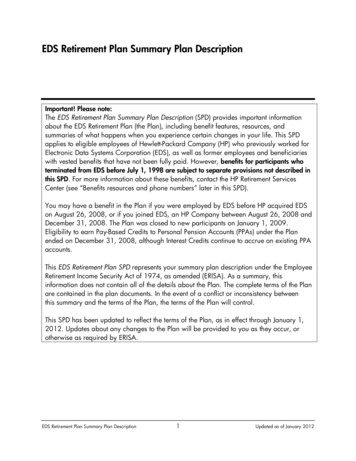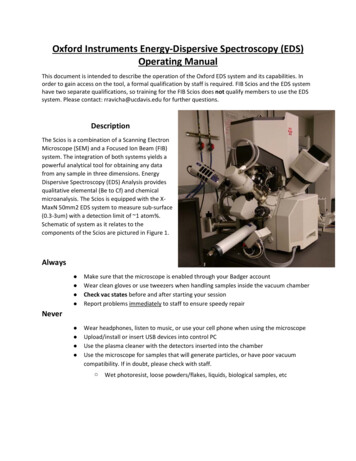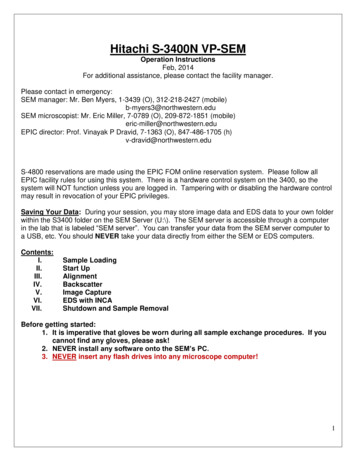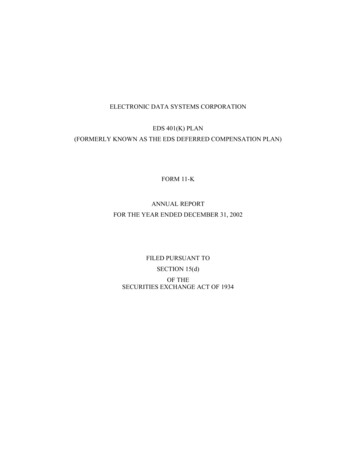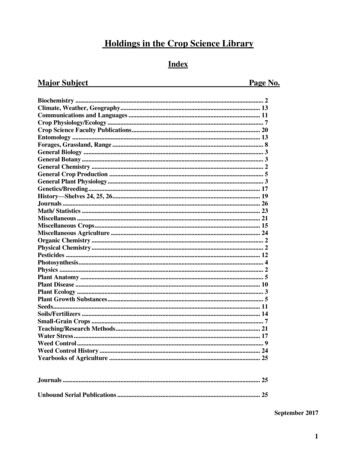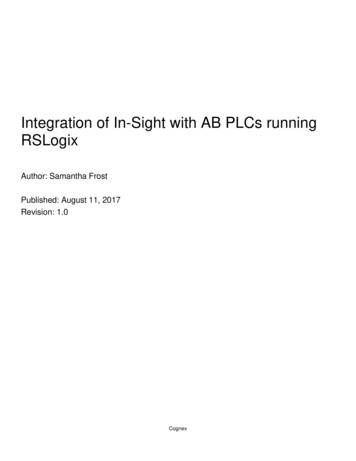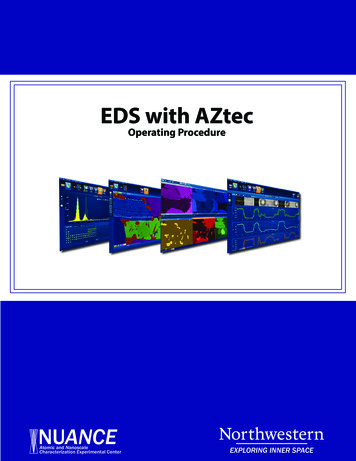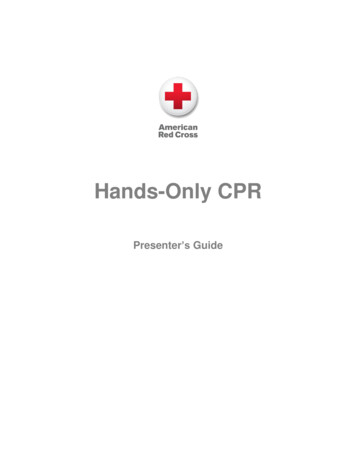
Transcription
EDS Diagnosis and HandsOn Management: Tighteningthe ConnectionsEDNF CONFERENCE 2013Providence, RIJeff Milunsky, M.D.Co-Director, Center for Human Genetics, Inc.Cambridge, MA
Disclosure Employed by the Center for HumanGenetics, Inc., a non-profit corporationthat performs genetic testing.MILUNSKY/CHG2
A Better Quality of LifeciteGenshtlaHeMedical CareWel l neEnv i ronmentMILUNSKY/CHGss3
Introduction Need Regional quarterback to direct carewith willing/helpful PCP of adults &children Holistic approach/Medical approach –combination Biopsychosocial approachMILUNSKY/CHG4
Introduction Importance of multimodal treatment Individualized treatment – same Rxparadigm does not work for all Importance of molecular diagnosisMILUNSKY/CHG5
Importance of Molecular Diagnosis Confirm diagnosis (Important forSSI/disability; IEP/504 Plans at school;other necessary job accommodations) Dispel label of hypochondriac and “itsall in your head”MILUNSKY/CHG6
Importance of Molecular Diagnosis Tracking through family (Especiallyimportant due to variable features)– Single mutation blood test Allows prenatal/preimplantationdiagnosis/more accurate recurrencerisksMILUNSKY/CHG7
Importance of Molecular Diagnosis Allows better anticipatory guidance– Vascular type vs. other types– Vascular events rarer with other types(but reported)MILUNSKY/CHG8
Differential Diagnosis Stickler Syndrome Loeys-Dietz Syndrome Marfan Syndrome “Benign Hypermobility Syndrome”MILUNSKY/CHG9
EDS: Multisystem Disorder Collagen is everywhere – not justskin/joints/bones Beighton Score Multiple different typesMILUNSKY/CHG10
Connective Tissue Evaluation History– Prenatal– Birth– Childhood– Major Medical ProblemsMILUNSKY/CHG11
Connective Tissue Evaluation History– Surgery and complications– Development– Imaging (Head/neck/spine/joint) Chiari, syrinx, tethered cordMILUNSKY/CHG12
Family History Known CTD Fractures/Subluxations/Dislocations CL/CP; Early arthritis Sudden deathMILUNSKY/CHG13
Family History Aneurysms Consanguinity Multiple miscarriages Intellectual Disability/Learning DisorderMILUNSKY/CHG14
Review of Systems Abnormal scarring/striae/bladder oruterine prolapse/hernias Cardiac – Chest pain/ palpitations/shortness of breath/Echo/EKGMILUNSKY/CHG15
Review of Systems Easy bruising GI – Vomiting/diarrhea/reflux/constipation/diet HearingMILUNSKY/CHG16
Review of Systems ID – Recurrent infections Musculoskeletal– Joint Pain/pain score/CRPS/RSD– Pes planus/scoliosisMILUNSKY/CHG17
Review of Systems Neurology – Headaches/Autonomicdysfunction/Raynaud’s phenomenon Ophthalmology – Myopia/retinaldetachmentMILUNSKY/CHG18
Review of Systems POTS – �brain fog” TMJ pain/malocclusion/gum recessionMILUNSKY/CHG19
Medications Oral Injectable Topical Vitamins/herbs/supplementsMILUNSKY/CHG20
Additional Therapies/Devices Biofeedback Physical Therapy/Occupational Therapy Massage, Trigger Point, Neuromuscular Therapy Acupuncture TENSMILUNSKY/CHG21
Additional Therapies/Devices Scheduled rest/modified schedule Prolotherapy Dry needling Splints/ring splintsMILUNSKY/CHG22
Additional Therapies/Devices Mattress/pillow/adjustable bed Diet (Gluten free, etc) Ergonomics Compression Stockings/abdominalbindingMILUNSKY/CHG23
Additional Therapies/Devices Braces Bite guards Shoe inserts Heat/ice Shower ChairMILUNSKY/CHG24
MILUNSKY/CHG25
Importance of Psychotherapy Chronic pain/anxiety/depression Cognitive Behavioral Psychodynamic Family Long termMILUNSKY/CHG26
Physical Exam Anthropometrics - Weight/height/headcircumference Facial features – Recessed chin/hypertelorism/bifid or broad uvula/pinched nose/sunken eyes/midfacehypoplasiaMILUNSKY/CHG27
Physical Exam Connective tissue signs – High palate/prominent ears Beighton score/Ghent score Atypical or Atrophic scar/striae Thumb/wrist/umbilical signMILUNSKY/CHG28
Physical Exam Hyperreflexia Skin – translucent, spheroids,prominent veins, tenting Scoliosis, pes planusMILUNSKY/CHG29
Molecular Diagnosis EDS type I/II– COL5A1 (most common)– COL5A2 (most common)– COL1A1 (rare) EDS type III– (minority TNX) 5%MILUNSKY/CHG30
Molecular Diagnosis EDS type IV (Vascular)– COL3A1 (98% detection rate) Stickler Syndrome I– COL2A1 (80-90% detection rate)MILUNSKY/CHG31
Molecular Diagnosis Loeys-Dietz Syndrome– TGFBR1 (most common)– TGFBR2 (most common)– TGFB2– SMAD 3MILUNSKY/CHG32
Molecular Diagnosis Marfan Syndrome– FBN1 (95% detection rate) Beals Contractural Arachnodactyly– FBN2 (90% detection rate)MILUNSKY/CHG33
MILUNSKY/CHG34
EDS Issues That NeedManagement Pain/muscle spasms/joint hypermobility Autonomic dysfunction/POTS/cardiacissues/aneurysms/aortic dilation/MVP/vascular fragility GI dysfunctionMILUNSKY/CHG35
EDS Issues That NeedManagement Vitamin D status, bone health, fractures,DEXA scan dynamics Pregnancy/Delivery/Postpartum DisabilityMILUNSKY/CHG36
EDS Issues That NeedManagement Chiari/syrynx/tethered cord/HA/migraines/CSF leak Myopia Dental issues/TMJ issues MisdiagnosisMILUNSKY/CHG37
EDS Issues That NeedManagement Mast cell issues Bladder/uterine prolapse Dual diagnosis that confound one singlediagnosis Sleep issuesMILUNSKY/CHG38
EDS Management – SystemsApproach Do not just treat one system at a time– Making improvements in each system willimprove quality of life Most systems connected– i.e. fix GI tract & Vitamin D level benefitspainMILUNSKY/CHG39
EDS Management Individualize care & recommendations Create Care Team that workscollaboratively with patients and PCP’s Treat whole patient and familyMILUNSKY/CHG40
A Better Quality of Life Reasonable and achievable goalMILUNSKY/CHG41
MILUNSKY/CHG 7 Importance of Molecular Diagnosis Tracking through family (Especially important due to variable features) - Single mutation blood test Allows prenatal/preimplantation diagnosis/more accurate recurrence risks

